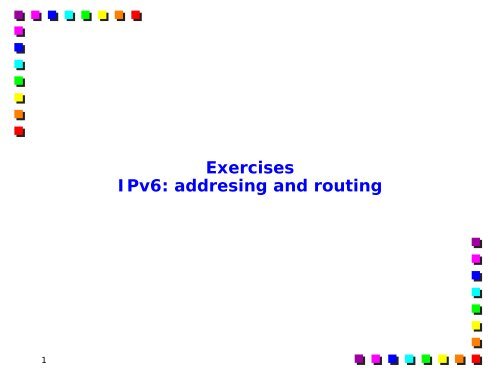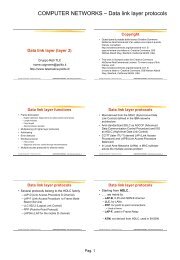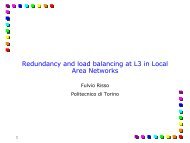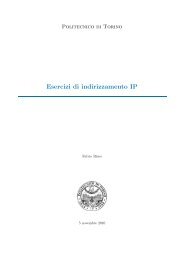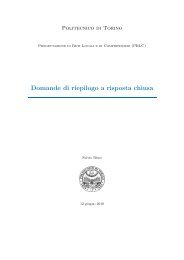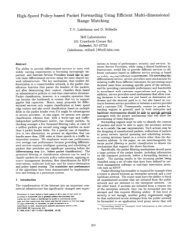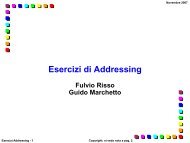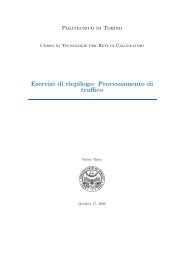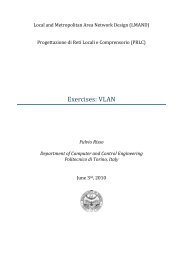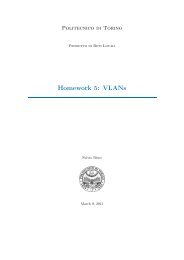IPv6 Exercises
IPv6 Exercises
IPv6 Exercises
You also want an ePaper? Increase the reach of your titles
YUMPU automatically turns print PDFs into web optimized ePapers that Google loves.
1<strong>Exercises</strong><strong>IPv6</strong>: addresing and routing
Esercizio 1: Stateless configurationGiven the configuration in the figure,assuming that Router Advertisement isenabled only in R1, which <strong>IPv6</strong> addressesare obtained by the host interface withstateless configuration?R1InternetR22001:1:0:1::1/64 2001:1:0:7::1/64HostPossible answers:A) 2001:1:0:1:20b:5dff:fe4c:3a6b, 2001:1:0:7:20b:5dff:fe4c:3a6b, fe80::20b:5dff:fe4c:3a6bB) 2001:1:0:1:20b:5dff:fe4c:3a6b, fe80:1::20b:5dff:fe4c:3a6bC) 2001:1:0:7:20b:5dff:fe4c:3a6b, fe80::20b:5dff:fe4c:3a6bD) 2001:1:0:1:20b:5dfe:ff4c:3a6b, fe80::20b:5dff:fe4c:3a6bE) 2001:1:0:1:20b:5dff:fe4c:3a6b, fe80::20b:5dff:fe4c:3a6b2
AnswerA) Wrong, because R2 does not send Router Advertisement messages,and the prefix 2001:1:0:7::/64 cannot be configured in the host.B) Wrong, because the link local prefix is wrong (FE80:1::/64, while itshould be FE80::/64)C) Wrong, because the global address has a prefix derived from R2,which does not advertize it.D) Wrong. The public <strong>IPv6</strong> address is valid, but the interface ID isincorrectly obtained from the MAC address (note that the two bytesFF and FE are misplaced). Since we assume stateless configuration,the address is wrong.E) Correct.3
Exercise 2: Stateless configurationGiven the network depicted in the figure.Assuming that R1 is not enabled to send RouterAdvertisement messages, indicate:R1Internet1) the addresses configures in H12001:1:0:1::1/642) the packets generated by H1 at bootstrapH1H23) the packets generated by H1 when the latterexecutes a ping addressed to H2, assuming thatit knows the destination <strong>IPv6</strong> addressMAC 00:01:04:76:2A:5CMAC 00:01:04:78:8D:2B4) the packets generated by H1 when it starts aTCP connection with an host in Internet4
Answer 1: H1 addressesThe only type of address is the link-local.Interface ID:MAC 00:01:04:76:2A:5C => IF_ID 0201:04FF:FE76:2A5C=> link local address: FC80::0201:04FF:FE76:2A5C5
Answer 2: packets generated at bootBefore assuming valid its link-local address, H1 should executea Duplicate Address Detection (2 packets) procedure, then itsends a packet to the group “all routers” to verify that a routerexists. Note that the latter packet is not sent as a default in allthe operating systems.Packet 1:[Eth] 000104-762A5C => 3333FF-762A5C[<strong>IPv6</strong>] :: =>FF02::1:FF76:2A5C (Len 64)[ICMP6] Neighbor Solicitation: who has FE80::0201:04FF:FE76:2A5C?Packet 2:[Eth] 000104-762A5C => 3333FF-762A5C[<strong>IPv6</strong>] FE80::0201:04FF:FE76:2A5C =>FF02::1:FF76:2A5C (Len 72)[ICMP6] Group Membership Report (FF02::1:FF76:2A5C)Packet 3:[Eth] 000104-762A5C => 3333FF-000002[<strong>IPv6</strong>] FE80::0201:04FF:FE76:2A5C =>FF02::2 (Len 56)[ICMP6] Router solicitation6
Answer 3: ping to H2First of all, it is necessary to coompute the <strong>IPv6</strong> link-local address ofH2. Then, two packets are generated for the neighbor solicitationmechanism, followed by ICMP echo request/reply packets.<strong>IPv6</strong> address of H2: FE80::0201:04FF:FE78:8D2B (MAC: 00:01:04:78:8D:2B)Packet 1:[Eth] 000104-762A5C => 3333FF-788D2B[<strong>IPv6</strong>] FE80::0201:04FF:FE76:2A5C =>FF02::1:FF78:8D2B (Len 72)[ICMP6] Neighbor Solicitation: who has FE80::0201:04FF:FE78:8D2B?Packet 2:[Eth] 000104-788D2B => 000104-762A5C[<strong>IPv6</strong>] FE80::0201:04FF:FE78:8D2B => FE80::0201:04FF:FE76:2A5C (Len 72)[ICMP6] Neighbor Advertisement: I am FE80::0201:04FF:FE78:8D2B at 000104-788D2BPacket 3:[Eth] 000104-762A5C => 000104-788D2B[<strong>IPv6</strong>] FE80::0201:04FF:FE76:2A5C => FE80::0201:04FF:FE78:8D2B (Len 72)[ICMP6] Echo RequestPacket 4:[Eth] 000104-788D2B => 000104-762A5C[<strong>IPv6</strong>] FE80::0201:04FF:FE78:8D2B => FE80::0201:04FF:FE76:2A5C (Len 72)[ICMP6] Echo Reply7
Answer 4: TCP connection over InternetSending packets to an host in Internet is impossible, becauseH1 has no default gateway configured.H1 is only able to communicate with hosts in its same subnet,by using the link-local address.8
Exercise 3 : PINGGiven the configuration shown in the figure.Assuming that R1 is not enabled to send RouterAdvertisement messages, indicate what is theflow of packets when, in H1, the user types thecommand “PING 2001:1:0:2::2”.Assume that the neighbor cache is empty.R1Internet2001:1:0:1::1/642001:1:0:2::1/64MAC: 00-AA-BB-CC-DD-EEH1H2<strong>IPv6</strong>: 2001:1:0:1::2/64DG: 2001:1:0:1::1MAC 00:01:04:76:2A:5C<strong>IPv6</strong>: 2001:1:0:2::2/64DG: 2001:1:0:2::1MAC 00:01:04:78:8D:2B9
Answer: Ping to H2 (1)Packet 1 (ICMPv6 Neighbor Solicitation from H1 to R1):[Eth] 000104-762A5C => 3333FF-000001[<strong>IPv6</strong>] 2001:1:0:1::2 =>FF02::1:FF00:1 (Len 72)[ICMP6] Neighbor Solicitation: who has 2001:1:0:1::1 ?Packet2 (ICMPv6 Neighbor Advertisement from R1 to H1):[Eth] 00AABB-CCDDEE => 000104-762A5C[<strong>IPv6</strong>] 2001:1:0:1::1 => 2001:1:0:1::2 (Len 72)[ICMP6] Neighbor Advertisement: I am 2001:1:0:1::1 at 00AABB-CCDDEEPacket 3 (ICMPv6 Echo Request to R1):[Eth] 000104-762A5C => 00AABB-CCDDEE[<strong>IPv6</strong>] 2001:1:0:1::2 => 2001:1:0:2::2 (Len 72)[ICMP6] Echo RequestPacket 4 (ICMPv6 Neighbor Solicitation from R1 to H2):[Eth] 00AABB-CCDDEE => 3333FF-000002[<strong>IPv6</strong>] 2001:1:0:2::1 =>FF02::1:FF00:2 (Len 72)[ICMP6] Neighbor Solicitation: who has 2001:1:0:2::2 ?Packet 5 (ICMPv6 Neighbor Advertisement from H2 to R1):[Eth] 000104-788D2B=> 00AABB-CCDDEE[<strong>IPv6</strong>] 2001:1:0:2::2 => 2001:1:0:2::1 (Len 72)[ICMP6] Neighbor Advertisement: I am 2001:1:0:2::2 at 000104-788D2BPacket 6 (ICMPv6 Echo Request from R1 to H2):[Eth] 00AABB-CCDDEE => 000104-788D2B[<strong>IPv6</strong>] 2001:1:0:1::2 => 2001:1:0:2::2 (Len 72)[ICMP6] Echo RequestPacket 7: (ICMPv6 Echo Reply from H2 to R1):[Eth] 000104-788D2B => 00AABB-CCDDEE[<strong>IPv6</strong>] 2001:1:0:2::2 => 2001:1:0:1::2 (Len 72)[ICMP6] Echo Reply...10
Answer: Ping to H2 (2)H1R1H2Neighbor SolicitationNeighbor AdvertisementEcho RequestNeighbor SolicitationNeighbor AdvertisementEcho RequestEcho ReplyEcho Reply11
Exercise 4It is given the capture file (listed below) of a PING command betweentwo hosts. What is the reason of the missing response to the ICMPEcho Request packet.[Eth] 001121-3AF4D2 => 3333FF-030001 [<strong>IPv6</strong>] 2001:1A60:1:1::3:2 =>FF02::1:FF03:1 (Len 72) [ICMP6] Neighbor Solicitation: who has 2001:1A60:1:1::3:1?[Eth] 001121-3B0726 => 001121-3AF4D2 [<strong>IPv6</strong>] 2001:1A60:1:1::3:1 => 2001:1A60:1:1::3:1 (Len 72) [ICMP6] Neighbor Adv.: I am 2001:1A60:1:1::3:1 at 001121-3B0726[Eth] 001121-3AF4D2 => 001121-3B0726 [<strong>IPv6</strong>] 2001:1A60:1:1::3:2 => 2001:1A60:1:2::16:2 (Len 72) [ICMP6] Echo Request[Eth] 001121-3B0726 => 3333FF-160002 [<strong>IPv6</strong>] FE80::0211:21FF:FE3B:0726 =>FF02::1:FF16:2 (Len 72) [ICMP6] Neighbor Solicitation: who has 2001:1A60:1:2::16:2?[Eth] 001121-3B01F8 => 001121-3B0726 [<strong>IPv6</strong>] 2001:1A60:1::2::16:2 => FE80::0211:21FF:FE3B:0726 (Len 72) [ICMP6] Neighbor Adv.: I am 2001:1A60:1:2::16:2 at 001121-3B01F8[Eth] 001121-3B0726 => 001121-3B01F8 [<strong>IPv6</strong>] 2001:1A60:1:1::3:2 => 2001:1A60:1:2::16:2 (Len 72) [ICMP6] Echo Request[Eth] 001121-3B01F8 => 3333FF-300001 [<strong>IPv6</strong>] FE80::0211:21FF:FE3B:01F8 =>FF02::1:FF30:1 (Len 72) [ICMP6] Neighbor Solicitation: who has 2001:1A60:1:2::30:1?[Eth] 001121-3B01F8 => 3333FF-300001 [<strong>IPv6</strong>] FE80::0211:21FF:FE3B:01F8 =>FF02::1:FF30:1 (Len 72) [ICMP6] Neighbor Solicitation: who has 2001:1A60:1:2::30:1?[Eth] 001121-3AF4D2 => 001121-3B0726 [<strong>IPv6</strong>] 2001:1A60:1:1::3:2 => 2001:1A60:1:2::16:2 (Len 72) [ICMP6] Echo Request[Eth] 001121-3B0726 => 001121-3B01F8 [<strong>IPv6</strong>] 2001:1A60:1:1::3:2 => 2001:1A60:1:2::16:2 (Len 72) [ICMP6] Echo Request...12
AnswerIP: 2001:1A60:1:1::3:2DG: 2001:1A60:1:1::3:1IP1: 2001:1A60:1:1::3:1IP2: 2001:1A60:1:2:[????]IP3: FE80::0211:21FF:FE3B:0726IP1: 2001:1A60:1:2::16:2IP2: FE80::0211:21FF:FE3B:01F8DG: 2001:1A60:1:2::30:1IP: 2001:1A60:1:2::30:1H1R1H2R2Neighbor SolicitationNeighbor AdvertisementEcho RequestNeighbor SolicitationNeighbor AdvertisementEcho RequestNeighbor SolicitationEcho RequestEcho RequestNeighbor Solicitation13
Exercise 5: addressing planDefine an <strong>IPv6</strong> addressing plan for the network shown in the figure.Define also the static routes that should be configured in the tworouters, in order to have a correctly working system.350 host 120 host14
AnswerThe network is not connected to Internet. Hence, only link-localaddresses are sufficient.For sake of simplicity,it is possible to use /64 networks, even if thisleads to huge waste of addresses (in the point-to-point link, inparticular).Static Route:S FD00:0:0:3::/64 FD00:0:0:1::2Static Route:S FD00:0:0:2::/64 FD00:0:0:1::1:1:2FD00:0:0:1::/64FD00:0:0:2::/64FD00:0:0:3::/6415
Exercise 6: addressing planDefine an <strong>IPv6</strong> addressing plan for the network shown in the figure,and the interfaces where it makes sense to enable the routeradvertising process.InternetBuilding ABuilding BBuilding CPiano Floor 1Piano Floor 2Piano Floor 3Piano Floor 1Piano Floor 2Piano Floor 3Piano Floor 1Piano Floor 2Piano Floor 316
Answer (1)It is a network with limited size. It is possible to distributeaddresses in non hierarchical way, leaving to the internal router thetask of propagating reachability information.2001:760:400::/48Internet2001:760:400:0:/642001:760:400:2:/64Building A2001:760:400:1:/64Building BBuilding C2001:760:400:3:/642001:760:400:5:/642001:760:400:4:/642001:760:400:6:/642001:760:400:8:/642001:760:400:7:/64Floor 1Floor 3Floor 2Floor 1Floor 2Floor 3Floor 1Floor 2Floor 317
Answer(2)Aternatively, it is possible to use a hierarchical addressing.Router Advertisement should be enabled only in the lowerinterfaces of routers in the lowest level.2001:760:400::/48InternetArea: 2001:760:400:0:/522001:760:400:0:/642001:760:400:1000:/642001:760:400:2000:/64Building ABuilding BBuilding C2001:760:400:0100:/642001:760:400:200:/642001:760:400:300:/642001:760:400:0101:/64Floor 12001:760:400:301:/642001:760:400:201:/64Floor 3Floor 2Area: 2001:760:400:0:/5618
Answer (2) - Addendum• Strictly hierarchical addressing may be difficult to manage over along period• Addresses to be assigned to point-to-point link is a problem, because theywaste a non negligible amount of addresses• Normally, the hierarchical is used when the same organization is located indifferent sites, so that it is possible to know immediately the site of anhost from a simlpe inspection of its <strong>IPv6</strong> address• Inside each site, the solution is usually "anarchist"• Often, it is possible to use a specific range for point-to-point links betweenrouters• The "anachist" solution scales also for medium-large networks (fewhundreds routes)• The solution in the previuos slide is only one among several possible• Note the partitioning at /52 and /56: why?19
Exercise 7: multiple choice questionAt reboot, which address an <strong>IPv6</strong> host will acquire?A) It is not possible to know exactly the address, because the<strong>IPv6</strong> address is re-generated each time using a randomnumber to define the Interface IDB) A FE80::/32 addressC) As for the link-local, it will asseme the same address asbeforeD) The address is completely dependent from the informationacquired by the router20


